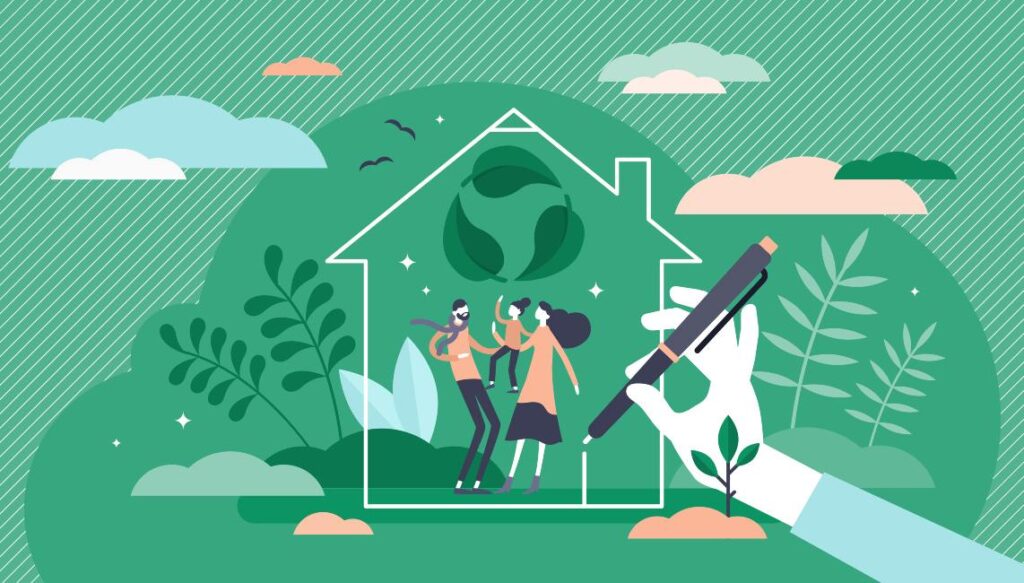It’s no secret that not all buildings are created equal. That applies to both aesthetics and sustainability. Homes and other buildings that don’t use sustainable design and building methods have higher utility bills, lower air quality, and potentially harmful substances in their paints and finishes. That’s bad for you and your wallet.
That’s where LEED comes into play! As the most widely accepted framework for sustainable and green building design in the world, it ultimately makes our lives, health and planet a better place.
What is LEED?
LEED stands for Leadership in Energy and Environmental Design, and it’s the basis for high-quality sustainable design and construction around the world. Created in 1993 by the United States Green Building Council (USGBC), LEED uses a point-based system to grade a home or building’s sustainability level.
The number of points a building can receive depends on extensive criteria that fall into the following categories:
- Location and transportation
- Sustainable sites
- Water efficiency
- Energy and atmosphere
- Materials and resources
- Indoor environmental quality
- Innovation
- Regional priority
Factors like available bicycle racks, daylight, interior lighting and even access to quality public transit can all affect a building’s LEED point score. However, those factors can vary depending upon which LEED rating system is used.
The 8 Main Types of LEED Rating Systems
Any building can be eligible for LEED certification, but not all buildings are graded equally. For example, schools aren’t assigned points in the same way that a home is. Each project has its own unique scorecard based on the following eight categories of LEED v4, the newest version of green building standards:
- BD+C: Building Design and Construction. Used for new buildings and major renovations, it usually covers buildings, but it can also sometimes cover apartment complexes with nine or more stories.
- ID+C: Interior Design and Construction. It’s mainly geared toward the design and construction of commercial building interiors, such as retail stores, hotels, and restaurants.
- O+M: Building Operations and Maintenance. This rating system applies to existing buildings undergoing surface-level changes with little or no plans for construction.
- ND: Neighborhood Development. It’s designed for neighborhood and community developments rather than a singular household or street.
- Homes: Builders use this system applies for single-family homes and low- to mid-rise multifamily homes, typically some type of apartment complex.
- Cities and Communities: This system encompasses entire cities and communities based on factors such as emissions, water, waste, transportation, education, prosperity and more.
- LEED Recertification: Employed for buildings that have already been certified by LEED, it makes sure they are up-to-par with the most recent LEED guidelines.
- LEED Zero: A newer, more difficult standard, it provides the highest level of accountability for already-certified LEED buildings. These projects have some type of net-zero goal, either carbon neutrality, zero waste, energy-neutral or water-neutral.
The 4 Levels of LEED Certification
After tallying the points, each building receives a grade, and it must earn a minimum of 40 points to earn the title of LEED-certified green construction. There are four possible scores you can achieve, each increasing in difficulty and rigor:
- Standard – 40-49 points
- Silver – 50-59 points
- Gold – 60-79 points
- Platinum – 80+ points
The higher the score, the better of a designation you receive as a mark of your building’s sustainability.
The Importance of LEED Certification
Not only does a LEED certification carry a lot of clout, but it also provides homes and businesses with some serious financial, environmental and health benefits.
- LEED saves money on energy costs. The better designed your home or building is, the less energy it will need to maintain operations and keep the lights on.
- LEED buildings use less water. Clean water is becoming an increasingly scarce source in today’s world. LEED buildings ensure that your building uses water responsibly.
- LEED improves indoor air quality. LEED plays a critical role in reducing smog and keeping employees healthy simply by ensuring the air you breathe is clean and free of unwanted particles.
- LEED improves the quality of life. With criteria such as quality views, daylight, thermal comfort and interior lighting, LEED promotes a better quality of life by creating healthy spaces. Additionally, employers in LEED-certified spaces report higher recruitment and retention rates and increased employee productivity.1
LEED Moves Humanity Forward
Although slow to become adopted by society, green living and sustainability are here to stay, and that definitely applies to homes and businesses around the world. The U.S. Green Building Council’s LEED certification program is one of the many ways that humanity has created to move us in the right direction.
Every day, we grow increasingly dependent on everyone to do their part and take care of our planet. At Chariot, we’re helping thousands of Texas residents and business owners do their part by providing 100% solar energy plans with no panels required.
The only question remains: What are you going to do?
Sources:

